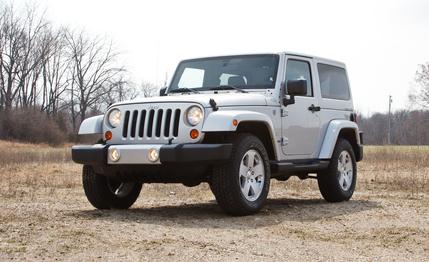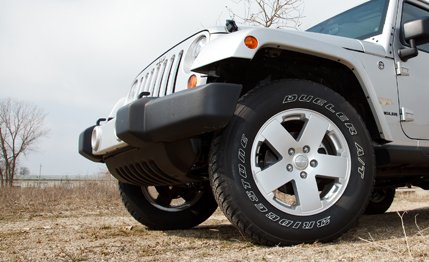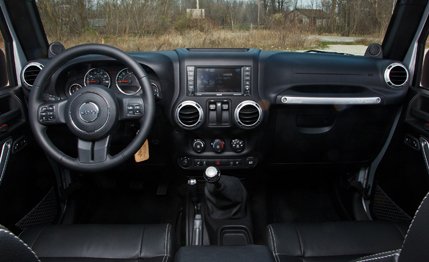
 Instrumented Test
Instrumented Test


To hard-core loyalists, there is just one true Jeep—and the Wrangler is it. Sure, most of the Jeep lineup can keep going when the pavement ends, but not with the aplomb and determination of this gritty rig. More important, none of those other so-called Jeeps has anything close to the Wrangler’s old-time testosterone levels. We’re talking seriously butch here, as well as seriously all-terrain.
Yes, there are all sorts of civilizing features. The Jeep has come a long way since the World War II all-purpose vehicle General George C. Marshall called “America’s greatest contribution to modern warfare.” Power windows probably wouldn’t have contributed much to modern warfare. Ditto air conditioning. Ditto Bluetooth connectivity. And World War II–era nav systems were something you could fold up and stick in your pocket.
Nevertheless, the Jeep people take pains to preserve the rugged Jeepish spirit of the original: Note the exposed door and hood hinges. The readily removable doors. The exterior hood latches. Taillights that aren’t faired into the body shell. Front fenders that don’t extend all the way down to the bumper—itself a distinct frontal element, rather than integrated with the front fascia.


And of course there’s a manual transmission, and a manual shifter for the four-wheel-drive transfer case. Jeep also offers a five-speed automatic option—we’ve recently tested it—for those who prefer its rock-crawling ease, but the manual is what you must have if you’re any kind of retro roughneck. Hey, how many automatic-transmission Jeeps were dodging Wehrmacht mortar rounds on Omaha Beach in 1944?
Six-Speed Exclusivity
So of course our Wrangler Sahara tester was equipped with the standard six-speed manual transmission and Command-Trac shift-on-the-fly four-wheel drive. Beyond its heavy-duty feel and positive engagements that refuse to be hurried, this gearbox (NSG 370 in your Chrysler parts inventory) has a couple of interesting distinctions.
For one, it’s exclusive to this particular vehicle. You won’t find it in any other Chrysler, Dodge, or Jeep. For another, this setup is the only way to get a stick paired with Chrysler’s 3.6-liter Pentastar V-6 (285 hp, 260 lb-ft of torque). Pentastar-powered Dodge Charger, Jeep Grand Cherokee, and Chrysler 300 models—among others—all transmit power via automatic transmissions. Besides in the Wrangler, its most recent installation was in the Chrysler Crossfire coupe and convertible, which disappeared in 2007.
Not So Fast


What you get with the V-6 and manual is a respectable 0-to-60-mph sprint—6.8 seconds—although thrust diminishes significantly as the speedo needle climbs. The quarter-mile consumes 15.3 seconds, arriving at 89 mph, and acceleration is nonexistent in sixth gear. This latter item isn’t too surprising. Sixth is very much an overdrive cog (0.797:1), and the 3.21:1 rear axle ratio makes it more so. Beyond that, at 4125 pounds the Sahara is pretty hefty, and that classic Jeep profile displaces mass quantities of air as speed accumulates.
In fact, haste isn’t present anywhere in the Wrangler’s dynamic persona. Excellent off-road ground clearance (10.6 inches front, 10.3 inches rear) isn’t a good prescription for brisk transient response, and 18-inch Bridgestone Dueler A/T tires (255/70) with tread blocks that look like Milk Bones limit pavement grip: 0.65 g, inhibited by the stability-control system. (For comparison, a big ol’ Jeep Grand Wagoneer we tested in 1988 pulled 0.69.) The tires also inhibit braking performance—207 feet from 70 mph, a pretty dismal number. None of the foregoing helps fuel economy. The EPA expects 17 mpg city, 21 on the highway. We logged 18 mpg.


Although ride quality is surprisingly compliant for a serious rock hopper, everything about the Jeep’s behavior on real roads, including its recirculating-ball steering (very retro), feels rubbery. However, the elements that make the Wrangler clumsy on the street make it a champ in the outback. And that’s what this ride is all about. If buyers expect any semblance of sportiness from a Wrangler, they’re headed for disappointment—and they may also be delusional.
Check, Please
Wranglers might be deliberately primitive, but they aren’t exactly cheap once you climb the trim levels—the base price of our Sahara model was $28,770—and the options list includes contemporary goodies that have little to do with rock crawling. For example, our test Sahara had heated leather front buckets ($900); a connectivity package (USB input, Bluetooth, etc., for $385); and a three-piece hardtop ($1715) with a rear window washer/wiper whose large housing takes a big bite out of the rear view, as do the vertical rear-seat headrests.
You might justify the $1035 Media Center package with its hard drive for music storage, SiriusXM Travel Link, and 6.5-inch touch screen, as it also includes a GPS nav system. Given the Wrangler’s capabilities, this equipment will probably just enable you to be even farther from anywhere when you realize you’re lost.
Be that as it may, in its element, the Wrangler is still more fun than about anything else capable of making tracks where there are none. Do we need to add that this kind of enjoyment is amplified by shifting for yourself? Didn’t think so.